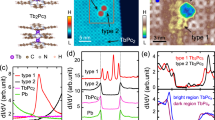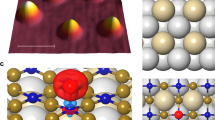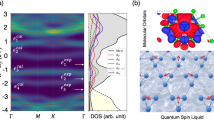Abstract
The magnetic properties of nanostructures that consist of a small number of atoms or molecules are typically determined by magnetic exchange interactions. Here, we show that non-magnetic, chemical interactions can have a similarly decisive effect if spin-moment-carrying orbitals extend in space and therefore allow the direct coupling of magnetic properties to wavefunction overlap and the formation of bonding and antibonding orbitals. We demonstrate this for a dimer of metal–molecule complexes on the Au(111) surface. A changing wavefunction overlap between the two monomers drives the surface-adsorbed dimer through a quantum phase transition from an underscreened triplet to a singlet ground state, with one configuration being located extremely close to a quantum critical point.
This is a preview of subscription content, access via your institution
Access options
Subscribe to this journal
Receive 12 print issues and online access
$209.00 per year
only $17.42 per issue
Buy this article
- Purchase on Springer Link
- Instant access to full article PDF
Prices may be subject to local taxes which are calculated during checkout




Similar content being viewed by others
References
Fu, Y.-S., Xue, Q.-K. & Wiesendanger, R. Spin-resolved splitting of Kondo resonances in the presence of RKKY-type coupling. Phys. Rev. Lett. 108, 087203 (2012).
Tsukahara, N. et al. Evolution of Kondo resonance from a single impurity molecule to the two-dimensional lattice. Phys. Rev. Lett. 106, 187201 (2011).
Prüser, H. et al. Interplay between the Kondo effect and the Ruderman–Kittel–Kasuya–Yosida interaction. Nature Commun. 5, 5417 (2014).
Wahl, P. et al. Exchange interaction between single magnetic adatoms. Phys. Rev. Lett. 98, 056601 (2007).
Minamitani, E., Nakanishi, H., Dio, W. A. & Kasai, H. Effect of RKKY interaction on the scanning tunneling spectra of a classic Kondo system—Two magnetic atoms adsorbed on a metal surface. J. Phys. Soc. Jpn 78, 084705 (2009).
Ruderman, M. A. & Kittel, C. Indirect exchange coupling of nuclear magnetic moments by conduction electrons. Phys. Rev. 96, 99–102 (1954).
Kasuya, T. Theory of metallic ferro- and antiferromagnetism on Zener’s model. Prog. Theor. Phys. 16, 45–57 (1956).
Yosida, K. Magnetic properties of Cu–Mn alloys. Phys. Rev. 106, 893–898 (1957).
Affleck, I., Ludwig, A. W. W. & Jones, B. A. Conformal-field-theory approach to the two-impurity Kondo problem: comparison with numerical renormalization-group results. Phys. Rev. B 52, 9528–9546 (1995).
Jones, B. A., Varma, C. M. & Wilkins, J. W. Low-temperature properties of the two-impurity Kondo Hamiltonian. Phys. Rev. Lett. 61, 125–128 (1988).
Jones, B. A. & Varma, C. M. Critical point in the solution of the two magnetic impurity problem. Phys. Rev. B 40, 324–329 (1989).
Fye, R. M., Hirsch, J. E. & Scalapino, D. J. Kondo effect versus indirect exchange in the two-impurity Anderson model: a Monte Carlo study. Phys. Rev. B 35, 4901–4908 (1987).
Esat, T. et al. Transfering spin into an extended π orbital of a large molecule. Phys. Rev. B 91, 144415 (2015).
Sachdev, S. Quantum criticality: competing ground states in low dimensions. Science 288, 475–480 (2000).
Franke, K. J., Schulze, G. & Pascual, J. I. Competition of superconducting phenomena and Kondo screening at the nanoscale. Science 332, 940–944 (2011).
Bork, J. et al. A tunable two-impurity Kondo system in an atomic point contact. Nature Phys. 7, 901–906 (2011).
Jabben, T., Grewe, N. & Schmitt, S. Spectral properties of the two-impurity Anderson model with varying distance and various interactions. Phys. Rev. B 85, 045133 (2012).
Bulla, R., Costi, T. A. & Pruschke, T. Numerical renormalization group method for quantum impurity systems. Rev. Mod. Phys. 80, 395–450 (2008).
Peters, R., Pruschke, T. & Anders, F. B. Numerical renormalization group approach to Green’s functions for quantum impurity models. Phys. Rev. B 74, 245114 (2006).
Weichselbaum, A. & von Delft, J. Sum-rule conserving spectral functions from the numerical renormalization group. Phys. Rev. Lett. 99, 076402 (2007).
Hofstetter, W. & Schoeller, H. Quantum phase transition in a multilevel dot. Phys. Rev. Lett. 88, 016803 (2001).
Nishimoto, S., Pruschke, T. & Noack, R. M. Spectral density of the two-impurity Anderson model. J. Phys. Condens. Matter 18, 981–995 (2006).
Jayaprakash, C., Krishna-murthy, H. R. & Wilkins, J. W. Two-impurity Kondo problem. Phys. Rev. Lett. 47, 737–740 (1981).
Jones, B. A. & Varma, C. M. Study of two magnetic impurities in a Fermi gas. Phys. Rev. Lett. 58, 843–846 (1987).
Lechtenberg, B. & Anders, F. B. Spatial and temporal propagation of Kondo correlations. Phys. Rev. B 90, 045117 (2014).
Borda, L. Kondo screening cloud in a one-dimensional wire: numerical renormalization group study. Phys. Rev. B 75, 041307 (2007).
Rohlfing, M. Electronic excitations from a perturbative LDA + GdW approach. Phys. Rev. B 82, 205127 (2010).
Greuling, A., Rohlfing, M., Temirov, R., Tautz, F. S. & Anders, F. B. Ab initio study of a mechanically gated molecule: from weak to strong correlation. Phys. Rev. B 84, 125413 (2011).
Greuling, A. et al. Spectral properties of a molecular wire in the Kondo regime. Phys. Status Solidi 250, 2386–2393 (2013).
Roch, N., Florens, S., Costi, T. A., Wernsdorfer, W. & Balestro, F. Observation of the underscreened Kondo effect in a molecular transistor. Phys. Rev. Lett. 103, 197202 (2009).
Nozières, P. & De Dominicis, C. T. Singularities in the x-ray absorption and emission of metals. III. One-body theory exact solution. Phys. Rev. 178, 1097–1107 (1969).
Ogawa, T., Kuwamoto, K., Isoda, S., Kobayashi, T. & Karl, N. 3,4:9,10-perylenetetracarboxylic dianhydride (PTCDA) by electron crystallography. Acta Crystallogr. B 55, 123–130 (1999).
Oleś, A. M. Antiferromagnetism and correlation of electrons in transition metals. Phys. Rev. B 28, 327–339 (1983).
Heitler, W. & London, F. Wechselwirkung neutraler Atome und homöopolare Bindung nach der Quantenmechanik. Z. Phys. 44, 455–472 (1927).
Bulla, R., Hewson, A. C. & Pruschke, T. Numerical renormalization group calculations for the self-energy of the impurity Anderson model. J. Phys.: Condens. Matter 10, 8365–8380 (1998).
Acknowledgements
B.L. and F.B.A. received support by the Deutsche Forschungsgemeinschaft through AN275/7-1. B.L., F.B.A. and M.R. acknowledge support from the NIC Jülich for CPU time under projects no. HHB00 and HMS17.
Author information
Authors and Affiliations
Contributions
R.T., C.W., T.E. and F.S.T. conceived the experiments. T.E. and R.T. conducted the experiments. T.E. analysed the experimental data. T.D., P.K. and M.R. performed density functional and many-body perturbation calculations and analysed the resultant data. B.L., F.S.T. and F.B.A. developed the theoretical model. B.L. and F.B.A. carried out the numerical renormalization group calculations and analysed the resultant data. T.E. prepared the figures. T.E., R.T., F.B.A. and F.S.T. wrote the paper, with significant contributions from all authors.
Corresponding author
Ethics declarations
Competing interests
The authors declare no competing financial interests.
Supplementary information
Supplementary information
Supplementary information (PDF 1739 kb)
Rights and permissions
About this article
Cite this article
Esat, T., Lechtenberg, B., Deilmann, T. et al. A chemically driven quantum phase transition in a two-molecule Kondo system. Nature Phys 12, 867–873 (2016). https://doi.org/10.1038/nphys3737
Received:
Accepted:
Published:
Issue Date:
DOI: https://doi.org/10.1038/nphys3737
This article is cited by
-
Two-impurity Kondo effect in potassium-doped single-layer p-sexiphenyl films
Science China Physics, Mechanics & Astronomy (2022)
-
Electronic Structure, Optical Properties, and Potential Applications of n-BN/WS2 (n = 1 to 4) Heterostructures
Journal of Electronic Materials (2021)
-
Real space manifestations of coherent screening in atomic scale Kondo lattices
Nature Communications (2019)
-
A standing molecule as a single-electron field emitter
Nature (2018)
-
Correlation-driven transport asymmetries through coupled spins in a tunnel junction
Nature Communications (2017)



